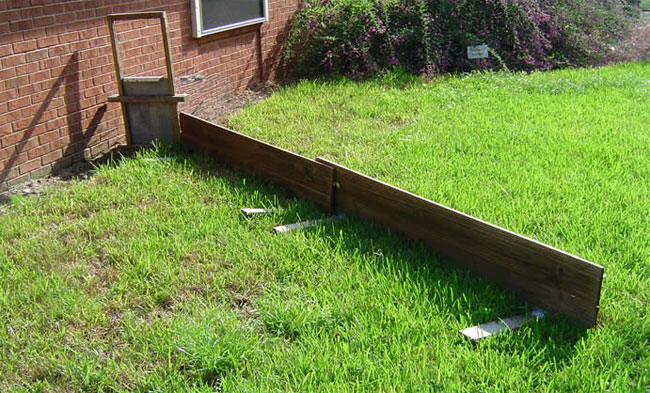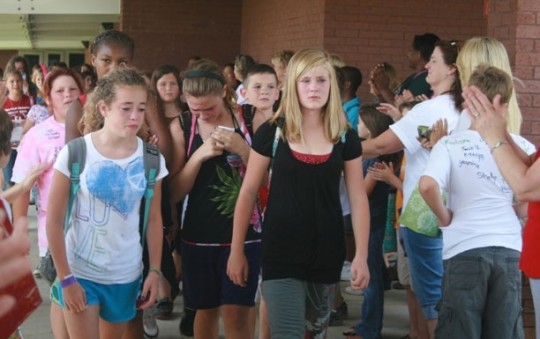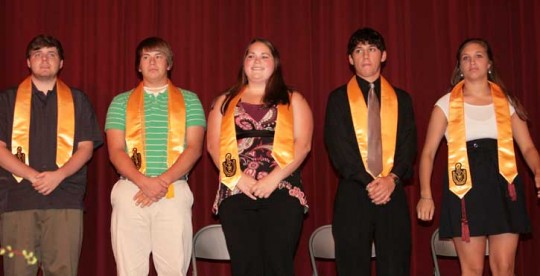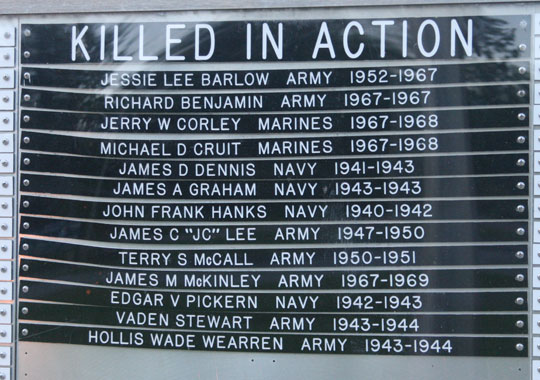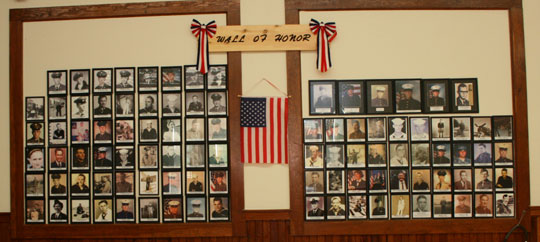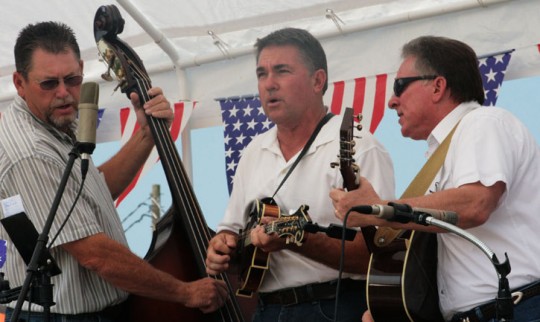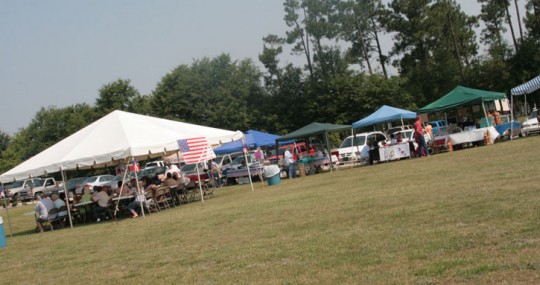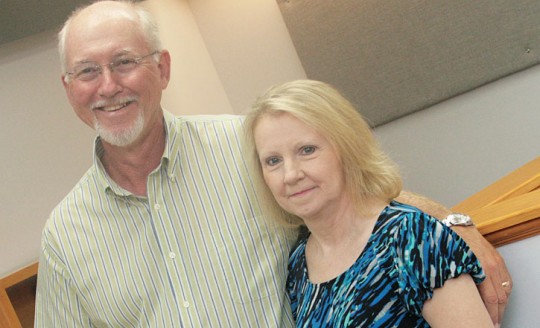Outwit and Outlast the Troublesome Armadillo
June 5, 2010
 Have you ever discovered your once beautiful green lawn looking like the surface of the moon, full of craters? If so, then you may have been visited by an alien-looking creature known as the armadillo.
Have you ever discovered your once beautiful green lawn looking like the surface of the moon, full of craters? If so, then you may have been visited by an alien-looking creature known as the armadillo.
Armadillos originated in South America. They are mammals. They are neither rodents nor marsupials and are not related to the opossum. Their closest living relative is the anteater and sloth.
The most easily recognized feature of an armadillo is its shell. Their common name, armadillo, is derived from a Spanish term meaning “little armored one”. All armadillos have shells, made of true bone, that cover their backs. Most armadillos also have bony rings or plates that protect their tails.
Digging machines
Armadillos are built to dig. They rely on this ability to escape danger and survive. They prefer sandy or loam soils that are relatively easy to excavate. Therefore, they are well adapted to Northwest Florida soils.
Armadillos typically rest in deep burrows during the day and become more active during the late evening, night, or early morning. These burrows are usually located under brushpiles, stumps, dense brush, or concrete patios, and are about 7 to 8 inches in diameter and can be up to 15 feet long. They often have several burrows throughout their territory.
Food sources
Armadillos feed primarily on insects. They also eat earthworms, scorpions, spiders, snails, and small vertebrates and their eggs. They consume large amounts of armyworms, cockroaches, ants, wasps, flies, beetles, and grasshoppers. They have been known to dig up entire yellow-jacket nests.
Some consider the armadillo a beneficial creature because they eat potential pests. Many consider the armadillo a pest because of their destructive ways. Armadillo can burrow under driveways and patios causing structural damage. Burrows in pastures can pose a potential hazard to livestock. And because armadillos usually search for food by rooting or digging in the ground, they can damage large areas of the lawn or garden.
Control measures
If you find that you cannot live with these creatures, the University of Florida recommends four ways to deal with armadillos.
- reducing the amount of water and fertilizer you apply to your lawn
- creating barriers (e.g., fences),
- live-trapping
- shooting offending individuals (check local ordinances)
The best solution (and the most expensive) is a stout fence to keep the armadillos out. If you take this route, make sure the fence is buried at least 18 inches into the ground, or they might just burrow under it.
Reducing the water and fertilizer applications to your lawn may help reduce armadillo damage. A moist lush landscape is perfect for earthworms and insect larvae. Armadillos love earthworms. Sometimes watering adjacent areas may attract armadillos away from a site.
Trapping can be frustrating and may require some ingenious thinking. Some tried and true trapping techniques are discussed at length in an online University of Florida publication by Dr. Russ Mizell at http://ufinsect.ifas.ufl.edu/armadillo.htm.
Remember that poison baits are illegal and ineffective. No chemical repellents or fumigants are registered for use in Florida.
Armadillos are very happy in Northwest Florida and are here to stay. If they have become unwelcomed house guests, put your thinking cap on and be committed to outwitting and outlasting this prehistoric-looking creature.
For more information, contact Theresa Friday at 850-623-3868 or email tlfriday@ufl.edu. Friday is the Residential Horticulture Extension Agent for Santa Rosa County.
Courtesy photos for NorthEscambia.com, click to enlarge.
Photo Gallery: Molino Park 5th Graders Say Goodbye
June 5, 2010
There were lots of tears, smiles and hugs Friday morning at Molino Park Elementary School as fifth graders took their final walk to the buses on the last day of school.
Teachers, parents and other students cheered on the Molino Park graduates as they said goodbye to their elementary years.
For a photo gallery, click here.
Pictured above and below: Fifth grade students take their final walk to the buses Friday morning at Molino Park Elementary School. NorthEscambia.com photos by Kristi Smith, click to enlarge.
Jay High Class Of 2010 Graduates
June 4, 2010
About 75 members of the Jay High School Class of 2010 graduated Thursday night at the school. Class valedictorian was Cierra Golden, and salutatorian was Rush Hendricks. About half of this year’s class earned a scholarship, with over $900,000 awarded. Submitted photo by Julie Booth-Moran for NorthEscambia.com, click to enlarge.
Photo Gallery: Northview Honors The Class Of 2010
June 4, 2010
The Northview Class of 2010 held Senior Honors Night at the school Thursday night.
During the honors night, Northview seniors were awarded $688,515 in scholarships.
For a complete NorthEscambia.com photo gallery from the event, click here.
The following awards, honors and scholarships were presented:
Athletic Awards
Aimee Clark, Bishop State Community College, $22,000
Amber McMillan, Bishop State Community College, $22,000
Austin Reid, Northwest Florida State College, $ TBA
Atmore Rotary Club Academic All Stars
Kaitlyn Caraway $400
Clinton Davis $400
Mark Shipps, Jr. $400
Kolbi Cobb $300
Bradley Lowery $300
Amber McMillan $300
Barrineau Park Historical Society
Felecia Settle — $500
Escambia River Electric Cooperative
Jessica Bloodsworth — $4,000 ($1000 for 4yrs)
FFA Alumni Scholarship
Micah Byars — $500
First National Bank and Trust
Clinton Davis– Sal. $50 Saving Bond
John E. Frenkel Sr. Educational Grants
Jessica Bloodsworth — $1000
Micah Byars — $1000
Navy League of Pensacola Award
Clinton Davis — $1000
Pensacola Civitan Club
Clinton Davis, Citizen of the Year – gift card
Pensacola Junior College
Principal Scholarship – Felicia Settle — $1600
Minority Scholarship –Angela Knoble-Rodderquez — $1600
2+2 PJC/University of Florida – Micah Byars — $3200
Quint and Rishy Studer Group Scholarship
Jackson Smith — $1000
Russell Stewart Memorial Scholarship
Jessica Bloodsworth — $500
Spirit of the Chief Award
John Sellers — $1000
Amber McMillan — $1000
United Bank of Atmore Award
Kaitlyn Caraway Val. $200 Stock/Money
University of West Florida
Mark Shipps — $17,000
US Army Scholar Athlete
Bradley Lowery — Medal
Candice Greenwell — Medal
USNA/NROTC
Jessica Bloodsworth — $180,000
Jim/Jumi Ross Memorial Scholarship
Clinton Davis — $750
Jessica Bloodsworth — $750
Walnut Hill Ruritan
Micah Byars, Glenn Key Ruritan Award — $500
Gavin Hinote, Walnut Hill Ruritan Service Award — $500
Beta Club
Jessica Bloodsworth
Kaitlyn Caraway
Kolbi Cobb
Clint Davis
Eric Ickeringill
Austin Lowery
Felicia Settle
Jackson Smith
Dakota Stuckey
Heather Ward
Alabama Power Scholarship
Kolbi Cobb — $1250
Armstrong Atlantic State University
Jessica Bloodsworth, Dollars for Scholars Scholarship $1000
American Welding Society Scholarship
Patrick Garrison, George Stone Technical Center — $3500
Auburn University
AU Board of Trustees
Kaitlyn Caraway & Brad Lowery — $1000 each
Harry Haman Annual Scholarship
Kaitlyn Caraway –$ 2500
College of Sciences and Mathematics
Bradley Lowery — $1500
Spirit of Auburn University Scholar
Kaitlyn Caraway & Brad Lowery — $10,000 each
Charles and Alice Mayson Scholarship
Mark Shipp — $12,000
FMS — 4 years, $10,816 each
Jessica Bloodsworth
Cody Parker
Micah Byars
Sarah Roth
Kaitlyn Caraway
John Sellars
Lennie Caum
Felicia Settle
Kolbi Cobb
Chris Sheets
Candice Greenwell
Jackson Smith
Seth Leonard
Heather Ward
Austin Lowery
FAS — 4 years — $16,552 each
Clint Davis
Brad Lowery
Eric Ickeringill
Mark Shipps
GSA — 2 years — $3,496 each
Jacob Garrison
Casey Hare
I.P. Pensacola Employees Scholarship
Clinton Davis — $1000
International Paper Co. Employee Martin Luther King Jr. Scholarship
Brittany Pete — $1300
Jacksonville University Academic Scholarship
Jessica Bloodsworth — $52,000 ($13,000/4yrs)
Jefferson Davis Community College Honors Scholarship
Kolbi Cobb – $4,320
National Wildlife Turkey Federation
Kolbi Cobb —$500
Gavin Hinote — $500
Poarch Band of Creek Indians Tuition Assistance Program
Wesley Morris — $30,000
Fred L. McGhee Memorial Indian Descent Scholarship
Heather Ward — $2,000
Take Stock in Children
Jessica Bloodsworth –$10,327 (4 yrs spread)
Tri-City Rotary Club
Felicia Settle — $500
Troy University Millennium Scholars Scholarship
Clinton Davis — $46,000
University of Mobile Center for Performing Arts
Carley Hetrick — $8,000 — $2,000 per yr
**SUBJECT AREA AWARDS**
Agriscience
Micah Byars — Outstanding Student
Art
Parish Kelley — Visual Arts HAA
Mallorie Okahashi—Outstanding Visual Arts Exemplary
Nathan Taylor — Outstanding Visual Arts Exemplary
Band/Chorus/Drama
Kolbi Cobb – Band
Mallory Okahashi – Band
Jackson Smith – Band
Olivia Nolen – Colorguard
Allison Spence – Colorguard
Carley Hetrick – Chorus
Thaddues Jones – Music
Nathan Taylor – Drama
Kayla Dempsey – Drama
Business Technology
Business Education Direct Study –HAA
Alex McDonald
Digital Design 2 – HAA
Olivia Nolen
Digital Design 2 – Outstanding Student
Kassandra Lett
Digital Design 3 – HAA
Alex McDonald
Web Design 3 – HAA
Dylan Stafford
Language Arts
Kaitlyn Caraway — Eng Hon — HAA
Kolbi Cobb — Reg. Eng – - HAA
Seth Leonard — Reg. Eng — Exemplary
Science
Kaitlyn Caraway– HAA Physics Honors
Clint Davis– Exemplary Physics Honors
Eric Ickeringill Most Inproved –Physics Honors
Jackson Smith – HAA Anatomy Honors
Seth Leonard – Exemplary Environmental Science
Spanish
Mark Shipps — HAA
Social Studies
Ashley Bonner — HAA Eco.
Amber McMillian — Exemplary
Technology Education
Jackson Smith – HAA–Construction Tech
Seth Leonard– HAA — Drafting 1
Jonathan Burkett—Drafting 2
Vocational Award
Bradley Griener
Yearbook Editor
Kaitlyn Caraway
Clint Davis
Dakota Stuckey
*HAA = Highest Academic Average
NorthEscambia.com photos, click to enlarge.
Under The Sea: Danceworks Holds Recital
June 2, 2010
 Heather Leonard’s Danceworks presented their annual recital “Under The Sea” recently at Ernest Ward Middle School.
Heather Leonard’s Danceworks presented their annual recital “Under The Sea” recently at Ernest Ward Middle School.
For a photo gallery from the event, click here.
Preschool :
Emma Gilmore, Madalyn Grimes, Ava Gurganus, Berklee Hall, Leah Hetrick, Meredith Johnston, Gracie Long, Mariana Minchew, Jordan Sanders, Aubrey Stuckey, Aleigh Thornton
5-6 year olds:
Bama Coburn, Sarah Margaret Hetrick, Jamison Janes, Makayla Minchew
7-8 year olds:
Shelby Bashore, Anna Grace Janes, Ansleigh Maholovich, Olivia Porter, Bailey Van Pelt
9-10 year olds:
Anna Belle Barberree, Karrie Gibson, Allison Johnson, Cassidy Murphy
11-12 year olds:
Jalyn Bodiford, Katie Born, Leah Fischer, RayAnn Free, Courtney Grim, Jenna Thornton, Brittney Ward
Teen:
Morgan Digman, Anna Fischer, Chloe Leonard, Jessica Lowery, Madi Minchew, Shelby Nielsen
Leonard started Danceworks in 1994. She has over 30 years of dance training, 25 years of teaching experience and serves as Danceworks’ director. The Danceworks students are instructed by Chelsea Sims, with 15 years of dance experience and five years as an assistant teacher. She is a former Northview High School cheerleader and Miss Northview.
Photos courtesy Ramona Fischer for NorthEscambia.com, click to enlarge.
Photos: A Look Back At A Long North Escambia Weekend
June 1, 2010
North Escambia Memorials Honor Those That Served
May 31, 2010
People across North Escambia and the country paused Monday to remember the brave men and women that have served our country today as we celebrated Memorial Day.
In North Escambia, there are memorials that honor those that have service in the military:
Walnut Hill
The largest such memorial in the North Escambia area, the Veteran’s Honor Wall has stood in front of the Walnut Hill Community Center since its dedication in 2003. There are about 300 names on the wall, including 13 names of soldiers killed in action. The wall honors those from the Walnut Hill area that have served in the nation’s military.
The Walnut Hill Veterans Wall is located in front of the Walnut Hill Community Center at 7850 Highway 97.
Century
About 30 of those that served from the Century area are honored on the Century Veteran’s Wall of Honor at Century’s Roadside Park on Highway 29.
Barrineau Park
The Wall of Honor inside the Barrineau Park Community Center honors over 100 people that have served in the military. The wall was a project of the Barrineau Park Historical Society.
Pictured above: The names of those killed in action on the Walnut Hill Veterans Wall. Pictured below: The Wall of Honor inside the Barrineau Park Community Center. NorthEsambia.com file photos, click to enlarge.
Photos: Molino Memorial Festival
May 30, 2010
The annual Molino Memorial Festival was held Saturday at CrossFaith Church. The day’s activities included arts and crafts vendors, children’s activities, plenty of food, guest speakers and live entertainment.
For more photos from the event, click here.
Pictured scenes from the Molino Memorial Festival Saturday morning. NorthEscambia.com photos, click to enlarge.
Fuller, Miller To Wed
May 30, 2010
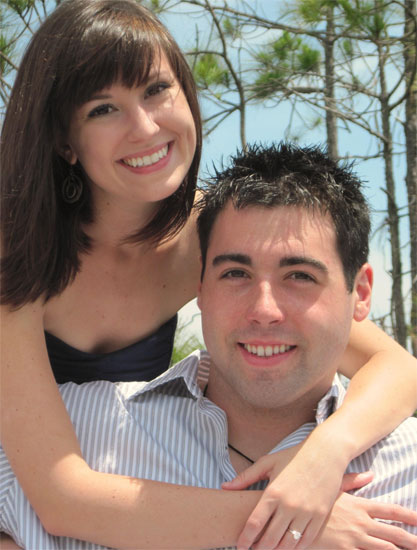 Danny and Lisa Fuller of Byrneville are pleased to announce the engagement and forthcoming marriage of their daughter, Devon Elizabeth, to Mr. William Ryan Miller, of Long Island, New York.
Danny and Lisa Fuller of Byrneville are pleased to announce the engagement and forthcoming marriage of their daughter, Devon Elizabeth, to Mr. William Ryan Miller, of Long Island, New York.
Devon is the granddaughter of Daniel and Betty Fuller of Pensacola and the late Emory and Ellen Wilkinson of Pensacola. Ryan is the son of William Miller and Marjorie Miller, both of Long Island, New York, and the grandson of Bob Hohenberger and Barbara Blackwelder of Westfield, North Carolina, and Maurice and Alice Blackwelder of Bardstown, Kentucky.
Devon is a graduate of Northview High School and is currently pursuing her RN Degree. Ryan is a graduate of Half Hollow Hills West High School and State University of New York Maritime where he earned a Bachelor’s of Engineering degree in Mechanical Engineering. Ryan is currently serving in the U. S. Navy at NAS Whiting Field, where he is in advanced helicopter flight training school.
The wedding will be held Tuesday, July 6, 2010, at the Naval Aviation Memorial Chapel aboard NAS Pensacola, and will be officiated by Rev. Tim Hawsey.
Retirement Party Honors Master Deputy Randy Murph
May 29, 2010
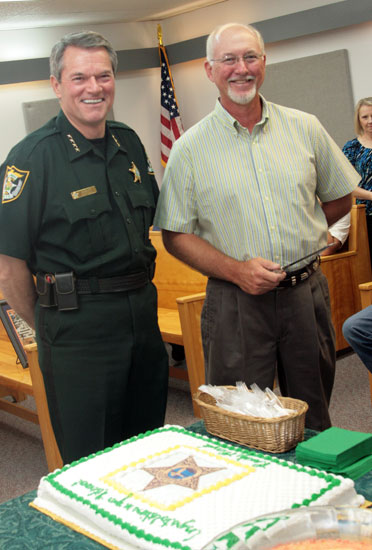 The Escambia County Sheriff’s Office honored Randy Murph of Byrneville with a retirement party Friday afternoon.
The Escambia County Sheriff’s Office honored Randy Murph of Byrneville with a retirement party Friday afternoon.
Murph retired recently after 27 years in law enforcement — 22 of those in North Escambia
Friends, family and coworkers, including Sheriff David Morgan, applauded Murph for his years of service.
Morgan said he remembered meeting Murph about six years ago and Murph’s comments about the need for the sense of community and belonging in the Escambia County Sheriff’s Office.
“This is not to say goodbye, but to wish you luck in whatever you do in the future,” Morgan told Murph.
“I want to thank the citizens of Escambia County for giving me the opportunity to protect them,” the recently retired master deputy said before thanking his wife, Mary, for standing behind him.
“It takes a special woman to be a cop’s wife,” he said. “When you walk out that door, your never know.”.
Murph started his law enforcement career in Escambia County, Alabama, working for then-Sheriff Tim Hawsey. He spent five years patrolling the 950 square miles of the county before moving south into Florida.
For the next 22 years, he worked for the Escambia County (Fla.) Sheriff’s Office, spending all of those years in North Escambia.
To read a previous NorthEscambia.com story about Randy Murph and his retirement, click here.
Pictured above: Retired Master Deputy Randy Murph (right) and Escambia County Sheriff David Morgan. Pictured below: Randy Murph and his wife Mary at his retirement party Friday afternoon in Century. NorthEscambia.com photos, click to enlarge.



